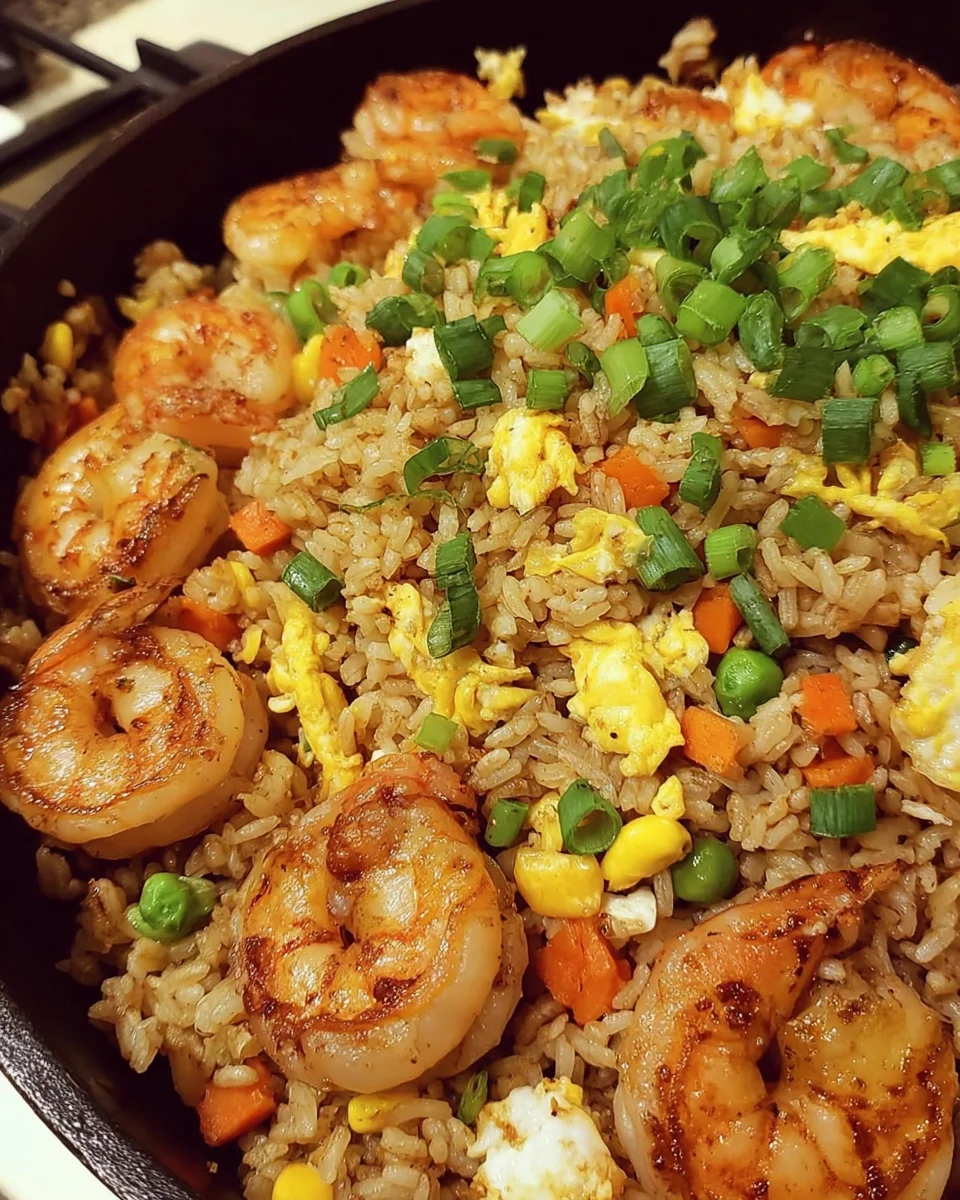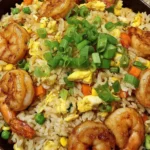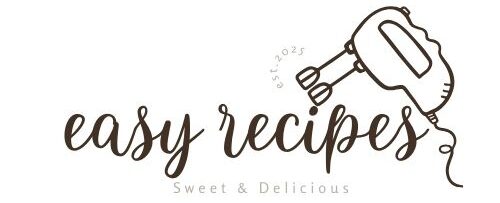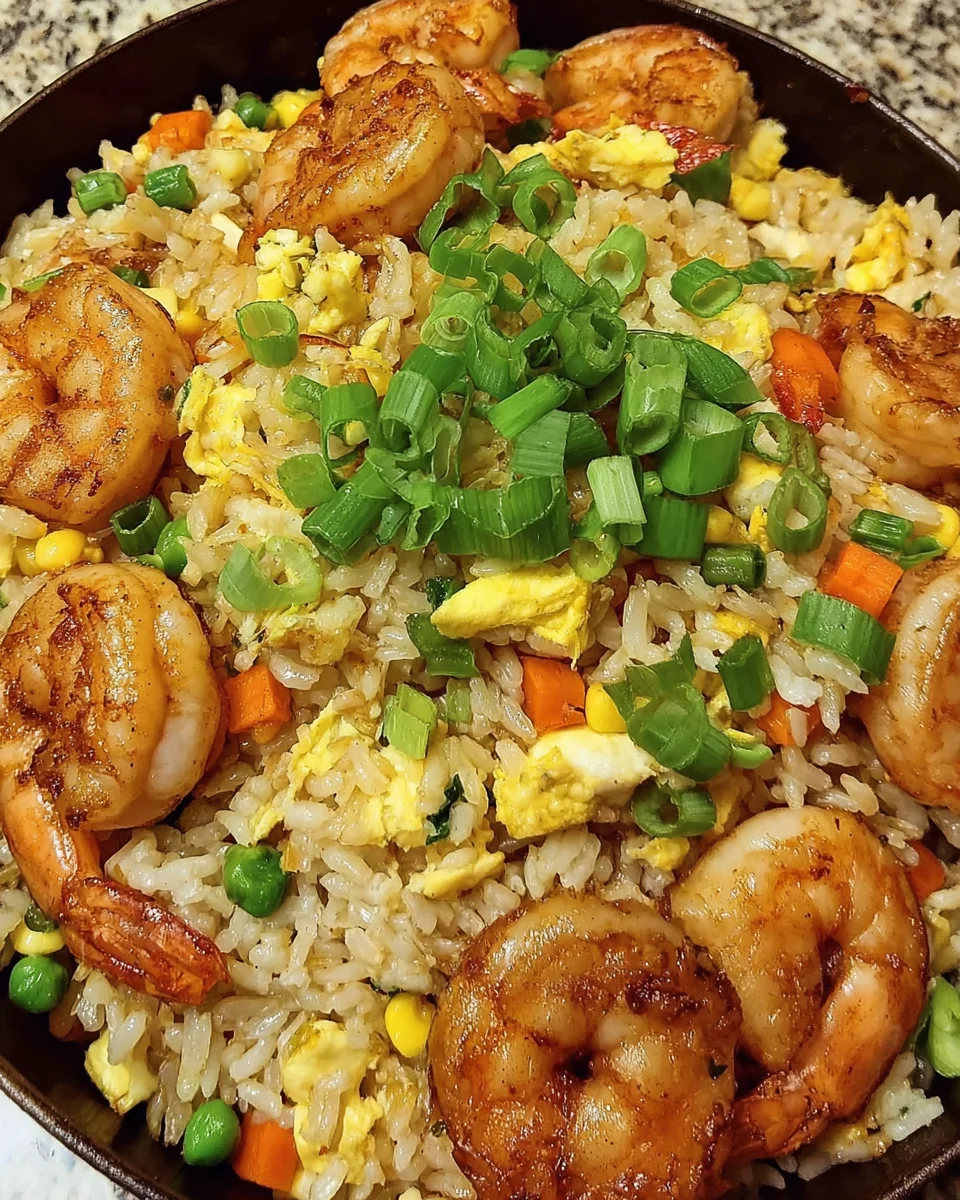Introduction to Shrimp Rice Vegetables
As a busy mom juggling work and family, I know how valuable quick, delicious meals can be. That’s where my Shrimp Rice Vegetables come into play! This one-pan delight combines succulent shrimp with colorful vegetables and fluffy rice, creating a dish that impresses everyone around the table. It’s not only mouthwatering but also incredibly easy to whip up, making it a perfect solution for hectic weekdays or a last-minute gathering with friends. Trust me, this dish is sure to become a staple in your cooking repertoire as it brings smiles and happy bellies!
Why You’ll Love This Shrimp Rice Vegetables
This Shrimp Rice Vegetables recipe is a true lifesaver in the kitchen. It’s not just quick and easy to make, but it also bursts with flavors that your family will adore. The vibrant colors of vegetables paired with tender shrimp make it visually appealing, too. Plus, it’s a wholesome meal that’s flexible, allowing you to swap ingredients based on what you have on hand. You’ll appreciate how this dish saves time while delivering a satisfying, hearty meal!
Ingredients for Shrimp Rice Vegetables
To create this delightful Shrimp Rice Vegetables dish, you’ll need a handful of fresh and accessible ingredients. Let’s break them down:
- Butter: Regular, unsalted butter gives richness to the dish. You can use ghee or even olive oil if you prefer.
- Neutral Oil: I like using grapeseed oil for its high smoke point, but canola or vegetable oil works just as well.
- Onion: A small to medium onion adds sweetness and depth. You can substitute it with shallots for a milder taste.
- Japanese Sweet Rice Wine (Mirin): This adds a subtle sweetness. If you don’t have it, a splash of white wine or a touch of honey can stand in.
- Pre-cooked White Rice: I use leftover rice to save time; you can also use frozen rice or prepare fresh rice in advance.
- Eggs: Whisked eggs add protein and a lovely texture. You can skip them for a vegetarian version.
- Soy Sauce: Lower sodium soy sauce keeps the flavor while balancing the saltiness. Feel free to use tamari as a gluten-free alternative.
- Oyster Sauce: This is key for umami flavor. If you’re vegetarian, opt for a mushroom sauce instead.
- Carrots: Thinly shredded carrot strips offer crunch and vibrant color. You could also use bell peppers or snap peas if they’re handy.
- Jumbo Shrimp: Peeled and deveined, they bring sweetness to the dish. Substituting with chicken or tofu is an option for different diets.
- Green Onions: Finely chopped, they provide a fresh pop of flavor. They’re optional but highly recommended for garnish.
- Garlic Powder: This adds a hint of garlicky goodness. Fresh garlic can be used, too, if you have it on hand.
- Frozen Corn and Peas: Both vegetables add sweetness and color. If fresh is what you have, use them instead.
- Toasted Sesame Oil: A drizzle of this oil at the end gives a warm, nutty flavor that’s signature in Asian cuisine.
- Salt and Pepper: Essential for seasoning—it’s all about personal taste!
For all the specific measurements, you can find them listed at the bottom of this article, perfect for your printing needs!
How to Make Shrimp Rice Vegetables
Prepare the Shrimp
Let’s kick things off by prepping the shrimp. In a bowl, give them a sprinkle of salt and a dash of pepper. This small step enhances their natural flavors. I love to use jumbo shrimp for that delightful bite. Make sure they’re peeled and deveined, ready to soak in the deliciousness. If you’ve got time, let the shrimp sit while you prep the veggies. This lets the seasoning work its magic!
Cook the Shrimp
Now for the fun part! Heat a large pan over medium-high heat and add some neutral oil. As it warms up, toss in about 2 tablespoons of butter until melted. Once it’s bubbling, add your seasoned shrimp. Cook them for about three minutes, flipping halfway through. Look for that beautiful pink color— that’s when you know they’re done. After cooking, remove the shrimp from the pan and set them aside for later. You want them perfectly tender for your dish!
Sauté the Vegetables
With the shrimp resting, it’s time for the vegetables. In the same pan, add another 4 tablespoons of butter to build rich flavors. Toss in finely chopped onions and give them a stir for a couple of minutes. As they soften, mix in the thinly shredded carrots. Sauté until both veggies are tender—about three minutes. This step is crucial! The onions become sweet, while the carrots add a lovely crunch, creating a flavor base that’s simply irresistible.
Scramble the Eggs
Next, we’ll add a protein boost to our shrimp rice vegetables with eggs. Push the sautéed veggies to the sides of the pan, creating a little open space. Pour in your whisked eggs and scramble them up for about a minute. Mix them with the veggies until everything is combined. This creates a lovely, fluffy texture throughout the dish. Keep an eye on them— you want them just cooked, not overdone!
Mix in the Rice
Now it’s rice time! Add your pre-cooked white rice directly into the pan with those flavorful veggies and eggs. Sprinkle in garlic powder, a pinch of salt, and both soy and oyster sauce for that umami kick. Stir everything together well, ensuring every grain of rice gets coated with the sauces. This not only adds flavor but also helps the rice take on a slightly golden hue. It’s a fantastic way to tie all the ingredients together!
Add Frozen Vegetables
Almost there! It’s time to fold in the frozen peas and corn. Add these colorful veggies right into the rice mix. I love how the frozen veggies add a pop of sweetness and vibrant color. Stir them in and let them heat through for a few minutes, thawing into the mix. This step increases the nutrients in your dish without compromising on flavor. Look at how beautiful it looks!
Combine Everything Together
Lastly, it’s time to bring everything together. Return your cooked shrimp to the pan and mix them gently with the rice and vegetable medley. This helps ensure that every bite has a balance of shrimp, rice, and veggies. Stir everything until well combined, and let it cook for a minute or two so the flavors meld together. Serve hot, and don’t forget to sprinkle some chopped green onions on top for that extra burst of flavor!
Tips for Success
- Prep all ingredients before you start cooking to streamline the process.
- Use leftover rice for faster cooking; it absorbs flavors better!
- Don’t overcrowd the pan when cooking shrimp; it helps achieve that perfect sear.
- Feel free to mix and match veggies based on your family’s favorites.
- Taste and adjust seasoning throughout the cooking process for best results.

Equipment Needed
- Large Skillet: A heavy-bottomed one ensures even heating. A frying pan can work too.
- Spatula: For stirring and flipping ingredients—silicone or wooden is best to avoid scratching.
- Mixing Bowls: Essential for prepping ingredients; any size will do.
- Measuring Cups and Spoons: Helpful for precise ingredient amounts; kitchen scales are also great for heavier items.
Variations on Shrimp Rice Vegetables
- Protein Swap: If shrimp isn’t your thing, try using chicken or tofu for a change.
- Spicy Kick: Add some sriracha or red pepper flakes for a bit of heat.
- Low-Carb Option: Replace rice with cauliflower rice for a lighter version.
- Herb Infusion: Incorporate fresh herbs like cilantro or basil for added flavor.
- Different Sauces: Experiment with teriyaki or hoisin sauce to customize the flavor profile.
Serving Suggestions for Shrimp Rice Vegetables
- Pair with a crisp green salad drizzled with sesame dressing for a light, refreshing contrast.
- Serve alongside steamed edamame sprinkled with sea salt for a protein-packed snack.
- Enhance the meal with a fruity iced tea or a chilled sparkling water with lime.
- For a beautiful presentation, garnish your dish with a sprinkle of sesame seeds and extra green onions.
FAQs about Shrimp Rice Vegetables
Can I use frozen shrimp for this recipe?
Absolutely! Frozen shrimp is a convenient option. Just thaw them in cold water before seasoning. They’ll work perfectly in your Shrimp Rice Vegetables!
What vegetables can I add to this dish?
Feel free to experiment! Bell peppers, snap peas, or broccoli are excellent additions. You can customize the Shrimp Rice Vegetables based on what your family enjoys.
How can I make this dish vegetarian?
To create a vegetarian version, simply replace the shrimp with tofu or your favorite meat substitute. Omitting the oyster sauce and eggs can also help you retain flavor without animal products.
Can I prepare this dish ahead of time?
Yes! You can prep all the ingredients in advance and store them separately in the fridge. Just mix and cook when you’re ready to enjoy a delicious meal with little fuss.
How do I store leftovers?
Store any leftovers in an airtight container in the refrigerator. They can be enjoyed for up to three days. Reheat in the microwave or on the stove for a quick meal.
Final Thoughts
Creating this Shrimp Rice Vegetables dish has been such a delightful experience for me. The joy of combining simple, fresh ingredients into a delightful meal fills my kitchen with warmth and love. It’s perfect for busy nights or when you want to impress family and friends with minimal effort. The rich flavors, vibrant colors, and comforting textures offer not just nourishment but also a sense of togetherness. I hope this dish brings as much happiness to your table as it does to mine. Remember, cooking is about sharing love, so let’s eat well and gather around together!
Print
Shrimp Rice Vegetables
- Total Time: 35 minutes
- Yield: Serves 4
- Diet: Low Calorie
Description
A mouthwatering one-pan dish featuring shrimp, rice, and colorful vegetables.
Ingredients
- 6 tbsp regular butter, unsalted
- 2 tbsp neutral oil like grapeseed
- 1 small to medium onion, chopped finely
- 1 tbsp Japanese sweet rice wine (mirin)
- 3 cups pre-cooked white rice
- 2 large eggs, whisked
- 1/4 cup soy sauce (lower sodium)
- 1 tbsp oyster sauce for umami flavor
- 1 cup thinly shredded carrot strips
- 1 lb peeled and deveined jumbo shrimp (tails off)
- 1/3 cup finely chopped green onions (optional for topping)
- 2 tsp garlic powder or granules
- 1/2 cup each of frozen corn and peas
- 2 tsp toasted sesame oil
- Salt and pepper to season as desired
Instructions
- Sprinkle a little bit of salt and a dash of pepper on the shrimp while in a bowl.
- Warm up some oil in a big pan over medium-high heat and melt about 2 tbsp of butter into it. Toss in the shrimp and cook them about 3 minutes, flipping them as you go. Remove onto a plate for later.
- Pour in the mirin to clear stuck bits from the pan.
- Melt 4 tbsp of butter in the pan. Toss in diced onions and stir them around for a couple of minutes. Add the shredded carrots and keep cooking both for an extra 3 minutes.
- Keep heat on medium and move the cooked veggies to the sides of the pan. Pour sesame oil into the open space and add eggs. Scramble everything together for another minute, letting veggies mix with the eggs.
- Mix the cooked rice with the veggies and eggs. Sprinkle in garlic powder, a pinch of salt, and some soy sauce along with the oyster sauce. Stir it all well until the moisture is absorbed and rice is a bit golden.
- Drop in the frozen peas and corn. Stir everything around until the veggies thaw and heat through.
- Return your cooked shrimp to the pan. Combine it with the rice mix so everything is evenly distributed.
- Sprinkle some chopped green onion on top if you’d like, and serve it hot.
Notes
- Feel free to customize the vegetables according to your preference.
- You can adjust the level of seasoning based on taste.
- This dish can be made ahead and reheated for leftovers.
- Prep Time: 15 minutes
- Cook Time: 20 minutes
- Category: Main Course
- Method: Stovetop
- Cuisine: Asian
Nutrition
- Serving Size: 1 plate
- Calories: 450
- Sugar: 3g
- Sodium: 600mg
- Fat: 20g
- Saturated Fat: 8g
- Unsaturated Fat: 10g
- Trans Fat: 0g
- Carbohydrates: 50g
- Fiber: 4g
- Protein: 25g
- Cholesterol: 180mg
Keywords: Shrimp, Rice, Vegetables, One-Pan Meal

